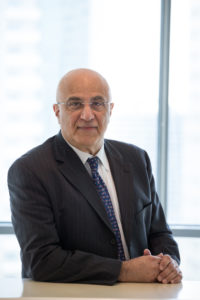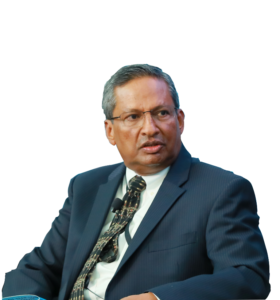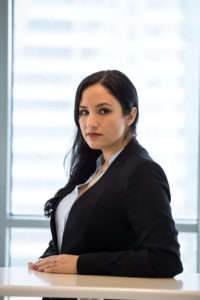In the wake of the merger of Green Technologies with Ted Jacob Engineering Group (TJEG), Surendar Balakrishnan and Hannah Jo Uy caught up with Ted Jacob, President, TJEG; Gabriela Soto Conde, Associate Commercial and Bids, TJEG, and Mario Seneviratne, Director, Green Technologies, for a chat. Excerpts from the interview…
Could you describe TJEG’s work with zero-energy buildings in the healthcare sector?

Ted Jacob
Ted Jacob: We are focused on healthcare-type projects, and healthcare facilities are one of the highest users of energy among all building types. We have introduced innovations in healthcare buildings and have been able to lower energy use by 30%, if you take ASHRAE 90.1.
Could you describe the innovations?
Jacob: We have introduced five to six major innovations, and then there are sub-innovations coming out from them. We were among the first to use 100% outside air with heat recovery. So, we have 100% outside air, which means we are bringing a whole lot of fresh air in; and you’re taking the heat, if it’s like really a design day outside, you take the cooling coming out from the building through piping going to the exhaust side and transferring the heat, and that’s about 60% efficient in recovering the heat in the hospitals. By doing that, you are reducing the ducting systems, so instead of having three ducting systems – supply, return and exhaust – we basically are reducing that to a two-duct system.
If you have a two-duct system, all of a sudden you free up the space in the ceiling, and you have fewer fire and smoke dampers, and so on. You are also able to improve the indoor air quality. You improve it by quite a bit; instead of returning the air to the hospital, which is one of the worst, you are supplying the outside air. The other aspect is that in a hospital the codes require a certain amount of fresh air coming in. You have to have enough air changes in a patient room, say. You have to have six air changes, of which two are outside air, and four are return air. But with the 100% outside air, you can go in at six, and the cooling load takes it, and you can reduce the supply air from six air changes to two air changes.
We adopted this approach in a hospital in California about five years ago, and it’s working perfectly. To put it in context, California has one of the strictest standards for healthcare design.
And then the third innovation that we are very excited about is displacement ventilation, where instead of supplying air at the ceiling level you supply at the lower level, which means your chiller plant is going to be reduced by about 15 to 20%. By reducing your chiller plant, you are reducing your air requirement, so your fan-related energy use goes down. Also, by supplying air at the lower level, if you calculate the energy, you save about
15-20% on the energy; and from an IAQ point of view, according to ASHRAE, you will supply 25-30% better indoor air quality.
What does the merger mean to Ted Jacob Engineering Group? How will it benefit the Middle East region?
Jacob: The main focus now is lowering energy use. In 50 years’ time, we will be running out of energy, unless we find new reserves. If buildings typically last 50 years plus, we are talking about the energy prices increasing exponentially. There will be a breakeven point, where you want to go to zero-energy or nearly zero-energy buildings. You first start with the systems being very efficient, just like our innovations are very important in taking
energy use down to 50%; on top of that, you go with sustainable measures, like adopting photovoltaic on site or solar energy for heating water; or, you can go the wind energy or geothermal route. Ultimately, it all depends on the cost benefit. If the cost of energy is way high, photovoltaic makes sense. If the payback is around five years, it makes sense to put PV to take it to zero energy.
I’m excited about this merger, as it will give us that extra knowledge and that extra concentration to take the building to net zero. We are focused on healthcare, but we want to take the same ideas to hotel projects or mixed-used developments.
Mario, how does this tie in with the net-zero-energy SABIC project in Saudi Arabia that you worked on?

Mario Seneviratne
Mario Seneviratne: Before I discuss the SABIC project, I feel the need to add that Ted’s company is a typical specialist MEP engineering firm. As for Green technologies, we are in consultancy – we normally don’t do large or heavy MEP jobs and, instead, focus on boutique and specialist jobs, like SABIC. This merger gives that sustainability expertise along with the heavy engineering expertise, and it will be an easy solution for the client, because normally the MEP is done by someone else and the sustainability is done by somebody else. Sustainability is an integral part of MEP engineering, we don’t see the demarcation line, so the coordination for the client and for the architect would be easier, because it’s one entity.
What would you offer that is different to the general structure of engineering companies in the construction field? I ask, because there is a lack of a critical mass of qualified MEP consultants or contractors to carry out specialised functions. How do you see the merger as contributing to the region in terms of good engineering practices?
Jacob: I travel globally, so I have a good idea what’s relevant around the world. I believe the US has a lot more advanced engineering in terms of innovations and project delivery. My firm in the US does highly technical buildings. We do healthcare, and we work with high-tech companies like Facebook Google and Oracle, which are very demanding. We have been looking for people for the past three years, I have not found people that are qualified. I would rather reduce my practice and do the right job instead of hiring these people, so we have been hiring people from school. It is very difficult to find a high level of expertise. It is the same here in this region, where I get at least 10-15 resumes every day, and I look at some of them and they’re just not good enough. After the crash in 2008, a lot of people just quit engineering, so we are a rare breed, a dying breed.
Seneviratne: I recently went to a project with a problem. The owner called me two years after doing the initial job. It’s going to cost millions to rectify the problem, which is the result of bad quality control and lack of knowledge on the part of the consultant and the contractor. Can you imagine going to one of the most prestigious buildings in Dubai, ripping out all the installation and finding joints? Again, you need high-calibre engineers on the site; if not, you would be sued in the US, correct?
Jacob: Yes, big time.

Gabriela Soto Conde
Seneviratne: In the US, they don’t only sue the engineer, they sue the company that did the selection of the engineer; the accounting firms are being sued, and this is something unique to this part of the world to have the legal structure to place a portion of the responsibility for the people that do the wrong thing, and until that comes in, no regulation will change it. Ted is a professional engineer, and so am I. We are committed. When we finish a design, we are committed for life. If something goes wrong, we are committed for life. In the Canadian system, the moment you get a complaint they take your membership out, and if the committee finds any wrongdoing, it would fine you as much as 25,000 dollars.
Gabriela Soto Conde: The merger will bring a commitment to quality and delivering value to our clients not only now but also in the long term.
What other best practices can we expect from the merger? One of the areas we hear people constantly complain about is the lack of an integrated project delivery mechanism. The considered opinion is that it’s crucial that the FM team is involved from the pre-design stage, so they don’t have to inherit a project they feel they can’t maintain properly throughout the life cycle.
Jacob: You mentioned a word not many people have used – IPD. I am a firm believer in IPD, where you bring a consultant, you bring an owner, you bring in a contractor. We are a big proponent for that. It is an idea that has not taken off in the Middle East. With our merger, we want to incorporate IPD.
Seneviratne: IPD is something LEED has been trying to do for the last probably 10 years. Integrated design approach is mandatory in healthcare, and it’s also something that at the beginning of the project, a good mechanical engineer and a good electrical engineer will always design; we don’t need an FM team to tell you that, but because of these procurement processes, you need to get the FM team right.
Surendar Balakrishnan is the Editor of Climate Control Middle East magazine, and Co-Founder and Editorial Director of CPI Industry. He may be contacted at surendar@cpi-industry.com
Hannah Jo Uy is Assistant Editor at Climate Control Middle East magazine. She may be contacted at hannah@cpi-industry.com
Copyright © 2006-2025 - CPI Industry. All rights reserved.